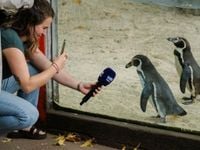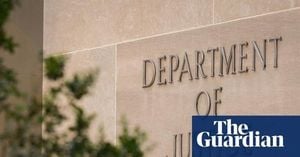Sixteen tiny, critically endangered western Santa Cruz tortoises shuffled into the spotlight at the Philadelphia Zoo on August 20, 2025, captivating animal lovers and conservationists alike. The hatchlings, each about the size of a biscuit, were celebrated in a red carpet event that highlighted both the fragility and resilience of their species. It was a scene filled with hope, as animal care specialists gently displayed the young tortoises along a pathway near their habitat, drawing attention to a remarkable conservation success story.
According to the Associated Press, the hatchlings were born in a series of hatches throughout 2025 to two venerable tortoises, Mommy and Abrazzo, both estimated to be around 100 years old. For the Philadelphia Zoo, this was a moment nearly a century in the making. Mommy, who arrived at the zoo in 1932, had not produced any offspring until Abrazzo joined her nearly five years ago, having been transferred from Riverbanks Zoo and Garden in Columbia, South Carolina. Their union proved fruitful, leading to the arrival of these highly prized hatchlings.
Lauren Augustine, the zoo’s director of herpetology, expressed both relief and excitement at the event. “Now this animal, who’s been in Philadelphia since 1932, will be represented here for, hopefully, another 100 years because her offspring are now part of our collection,” Augustine told the press, underscoring the significance of the moment.
The sixteen hatchlings are already making history at the zoo, and each has a story to tell. Four females that hatched early in the spring were named after beloved characters from the TV show Golden Girls, adding a touch of pop culture flair to the conservation effort. Three males followed in April, with another clutch in June producing three more females. The summer brought six additional males, rounding out the diverse group. The zoo uses nontoxic nail polish in different colors to distinguish the young tortoises from one another—a practical (and surprisingly charming) solution to the challenge of keeping track of the new arrivals.
The Philadelphia Zoo has invited donors to suggest a name for one of the male hatchlings, subject to approval. Other hatchlings have already been given unique names, including Zee, James, Colette, Soledad, Isabelle, Roger, Fausto, Caldero, Lee, Marigold Puddlefoot, and Kelpy. The sense of community involvement is palpable, as the zoo seeks to connect people to the fate of these remarkable creatures.
But the story of the Philadelphia Zoo’s tortoises is just one chapter in a much larger narrative about the fate of giant tortoises worldwide. Western Santa Cruz tortoises, native to the Galapagos Islands off the coast of Ecuador, are among the largest tortoise species on earth and can live up to 200 years. They are also among the most endangered, with habitat loss and introduced predators threatening their survival. The Philadelphia Zoo’s success is a beacon of hope for the species, and the hatchlings are expected to remain at the zoo for at least a year before being placed in different facilities across the country next fall to further bolster genetic diversity and species survival.
Mommy and Abrazzo, now the zoo’s oldest inhabitants, are considered highly genetically valuable. Their offspring are a win for conservationists, who see each new hatchling as a step away from extinction. The Philadelphia Zoo’s commitment to the species is further reflected in its care for other giants—Wilma and Betty, two giant Aldabra tortoises, also reside at the zoo. The broader conservation effort is echoed elsewhere: in June 2025, a 135-year-old Galapagos tortoise named Goliath became a father for the first time at Zoo Miami, another testament to the slow but steady progress in reptile conservation.
Meanwhile, across the Atlantic, the London Zoo was abuzz with activity of a different kind. On August 21, 2025, the zoo held its annual weigh-in event, an affair that blends scientific rigor with a dash of British theatricality. As reported by The Londoner, the weigh-in is a massive undertaking, with over 10,000 animals weighed and measured over several weeks. But on this particular day, it was a curated selection—including lemurs, tortoises, capybaras, penguins, a giant-hooded katydid, and a snail—that took center stage for the world’s media.
The ring-tailed lemurs, in particular, stole the show with their antics. As zookeepers wrangled the energetic primates into their hutches for weighing, the animals cavorted, capered, and even attempted to pick the keepers’ pockets. One zookeeper, with the patience of a parent, explained that the delays were due to the lemurs’ playful mood, adding a touch of humor to the proceedings. The event was attended by representatives from major photographic agencies and media outlets from around the globe, highlighting the public’s enduring fascination with the animal kingdom and the behind-the-scenes work that goes into caring for it.
At first glance, the Philadelphia and London zoo events might seem worlds apart—one a celebration of rare new life, the other an annual ritual of measurement and record-keeping. Yet both underscore the vital role that zoos play in conservation, research, and public engagement. The Philadelphia Zoo’s hatchlings are a testament to decades of patient stewardship and international collaboration. The London Zoo’s weigh-in, meanwhile, offers a glimpse into the meticulous care and scientific curiosity that underpin modern zoological practice.
These events also serve as a reminder of the challenges facing endangered species. The survival of the western Santa Cruz tortoise, for instance, depends not just on successful breeding in captivity but also on the protection of wild habitats and the management of threats like invasive species. Public events like the Philadelphia Zoo’s red carpet celebration and the London Zoo’s weigh-in help keep these issues in the spotlight, fostering a sense of connection and responsibility among visitors and supporters.
For the hatchlings at the Philadelphia Zoo, the journey is just beginning. Over the next year, they will grow under the watchful eyes of their caretakers, before embarking on new adventures in zoos and conservation centers across the country. For the zookeepers at London, the annual weigh-in is a chance to check in on the health and well-being of their charges, ensuring that each animal—from the smallest snail to the largest tortoise—receives the best possible care.
In a world where wildlife faces mounting threats, stories like these offer a measure of hope. They remind us that with patience, dedication, and a little bit of luck, it’s possible to turn the tide for some of the planet’s most remarkable—and vulnerable—creatures.




